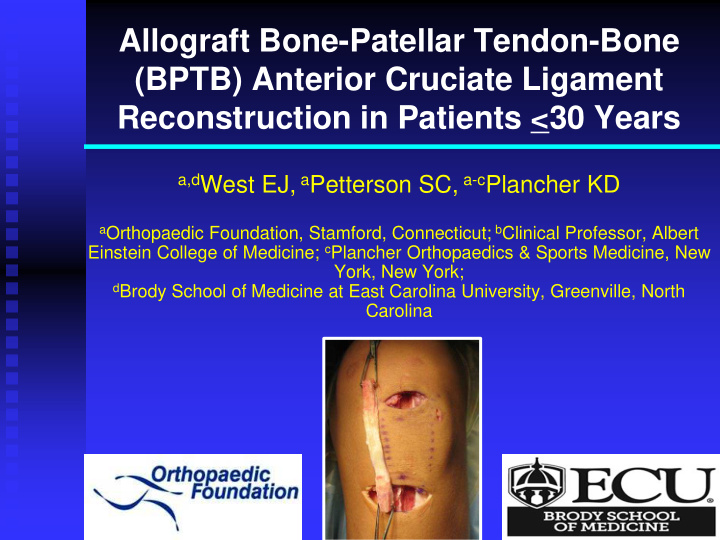



Allograft Bone-Patellar Tendon-Bone (BPTB) Anterior Cruciate Ligament Reconstruction in Patients <30 Years a,d West EJ, a Petterson SC, a-c Plancher KD a Orthopaedic Foundation, Stamford, Connecticut; b Clinical Professor, Albert Einstein College of Medicine; c Plancher Orthopaedics & Sports Medicine, New York, New York; d Brody School of Medicine at East Carolina University, Greenville, North Carolina
Disclosures November 2017 None
Allograft BPTB ACLR in Patients <30 Recent Literature BPTB Autograft Functionally More Stable Than Hamstring Autograft 2 Must Reproduce Mid- substance Anatomical Position Greater Anterior Knee Pain 3 Allograft Less Anterior Knee Pain Failure Rate 3-4x Greater Than Autograft 1,4-5 1) KaedingCC et al. Allograft Versus Autograft ACL Reconstruction: Predictors of Failure From a MOON Prospective Longitudinal Cohort. Sports Health. 2011. 3(1):73-81. Historically Higher in Young 2) Freedman KB et al. Arthroscopic ACL reconstruction: A meta analysis comparing patellar tendon and hamstring tendon autografts. AJSM. • Ages 10-19 2003. 31(1):1-11. 3) Mohtadi NG et al. Patellar tendon versus hamstring tendon autograft Greater Knee Laxity 5 for ACL rupture in adults. Cochrane Database Syst Rev. 2011 Sep 7;(9):CD005960. Worse Functional Outcomes z 4) MaletisGB et al. Reconstruction of the ACL: association of graft choice with increased risk of early revision. Bone Joint J. 2013. 95- B(5):623-8. 5) KraeutlerMJ et al. Bone-patellar tendon-bone autograft versus allograft in outcomes of ACLR: a meta-analysis of 5182 patients. AJSM. 2013 Oct;41(10):2439-48.
Allograft BPTB ACLR in Patients <30 Purpose of Investigation Purpose: Investigate Differences in Failure Rates and Functional Outcomes Between BPTB Allograft and Autograft ACL Reconstructions in Patients Less Than 30 Years of Age Hypothesis: Patients < 30 Years Undergoing Primary ACLR with BPTB Allograft or BPTB Autograft Will Have Equal Outcomes with Low Failure Rates
Allograft BPTB ACLR in Patients <30 Methods Inclusion/Exclusion Criteria Primary ACL Reconstruction Cohort Study: 1998 – 2017 Single Surgeon (KDP) 48 patients Allograft BPTB LifeNet (Virginia Beach, VA) Musculoskeletal Transplant Foundation (Edison, NJ) Autograft BPTB Exclusion Criteria Age <17 years old >30 years old Follow-Up >2 years Revision Surgery Osteochondral Drilling Multiligament Injury
Allograft BPTB ACLR in Patients <30 Methods Surgical Technique - Transtibial Autograft Patellar Tendon Cancellous Bone Graft 1/3 Thickness Closure Allograft Patellar Tendon Under 40 years of age Always 5+ Years Younger Than Patient Age No Terminal Irradiation Bioabsorbable Interference Screw (ConMed Linvatec, Largo, FL) Biphasic calcium phosphate Poly-L D-lactide (PLDLA) Meniscal Repair All-Inside OR Inside-Out
Allograft BPTB ACLR in Patients <30 Methods Post-Op Rehabilitation Protocol Conservative Rehab Program Home CPM: 2-3 Weeks Knee Brace 6 weeks: Post-Op Knee Brace • Locked: Progress From 10 o to 90 o Weeks 6 to 12 Post-Op • ACL Sport Specific Knee Brace Supervised Physical Therapy Month 5 Post-Op: • Return To Sport Specific Brace • Cut Workout Intensity In Half Cutting/Pivoting Sports 5 Months S/P – ACLR Interstitial Revascularization Adequate Proprioception Sport Test • No Sooner Than 6 Months
Allograft BPTB ACLR in Patients <30 Methods Data Collection Subjective Questionnaires Tegner Score Lysholm Score (0-100) IKDC Score (0-100) Physical Examination Pre & Post-Operative MRI/CT Scan Ligamentous Laxity Testing Lachman/Pivot-Shift Range of Motion Flexion & Extension KT-1000 5 lbs, 10 lbs, 20 lbs, Manual Max
Allograft BPTB ACLR in Patients <30 Methods Clinical Failure Graft Failure Definitions Recurrent Subjective Knee Instability Positive Lachman/Pivot Shift Test(s) Imaging Positive For ACL Graft Rupture (MRI)
Allograft BPTB ACLR in Patients <30 Results Patient Demographics BPTB ALLOgraft BPTB AUTOgraft P-Value (n=13) (n=35) 5 males 27 males Gender 8 females 8 females Patient Age 23.8 + 3.9 22.0 + 4.4 p=0.187 (years) Average Follow-Up 6.7 + 3.7 8.7 + 5.2 p=0.155 (years)
Allograft BPTB ACLR in Patients <30 Results Return To Sport Overall Failure Rate Basketball Allograft: N=0 (0%) 10.4% Autograft: N=1 (2.9%) 4 Years Post-op Successful BPTB Autograft Revision Other Soccer p = 0.324 29.2% 18.8% ALL Patients Returned To Pre-Operative Sport Baseball Skiing 20.8% 20.8% ALL Patients Regained A Tegner Score Of > 5 Range 5-9
Allograft BPTB ACLR in Patients <30 Results Functional Performance BPTB Allograft vs. BPTB Autograft NO Differences in Clinical Outcome (Significance p<0.05) Lysholm: p=0.380 IKDC: p=0.324 KT-1000 Manual Max: p=0.740 12 100 Anterior Tibial Translation 90 10 Functional Score 80 70 8 60 6 50 (mm) 40 4 30 20 2 10 0 0 Post-Op KT-1000 Man. Max Post-Op Lysholm Post-Op IKDC ALLOGRAFT AUTOGRAFT ALLOGRAFT AUTOGRAFT
Allograft BPTB ACLR in Patients <30 Conclusions Allograft BPTB ACLR is an Excellent Option for Patients Under 30 Years of Age Allows for Return to Pre-Operative Sport (ANY Sport, ANY Level) Equal Outcomes as Autograft BPTB ACLR No Evidence of Increased Failure Rate Allograft Selection Important Age Always > 5 Years of Patient No Terminal Irradiation Slow, Conservative Rehabilitation is Required
Thank You
Recommend
More recommend